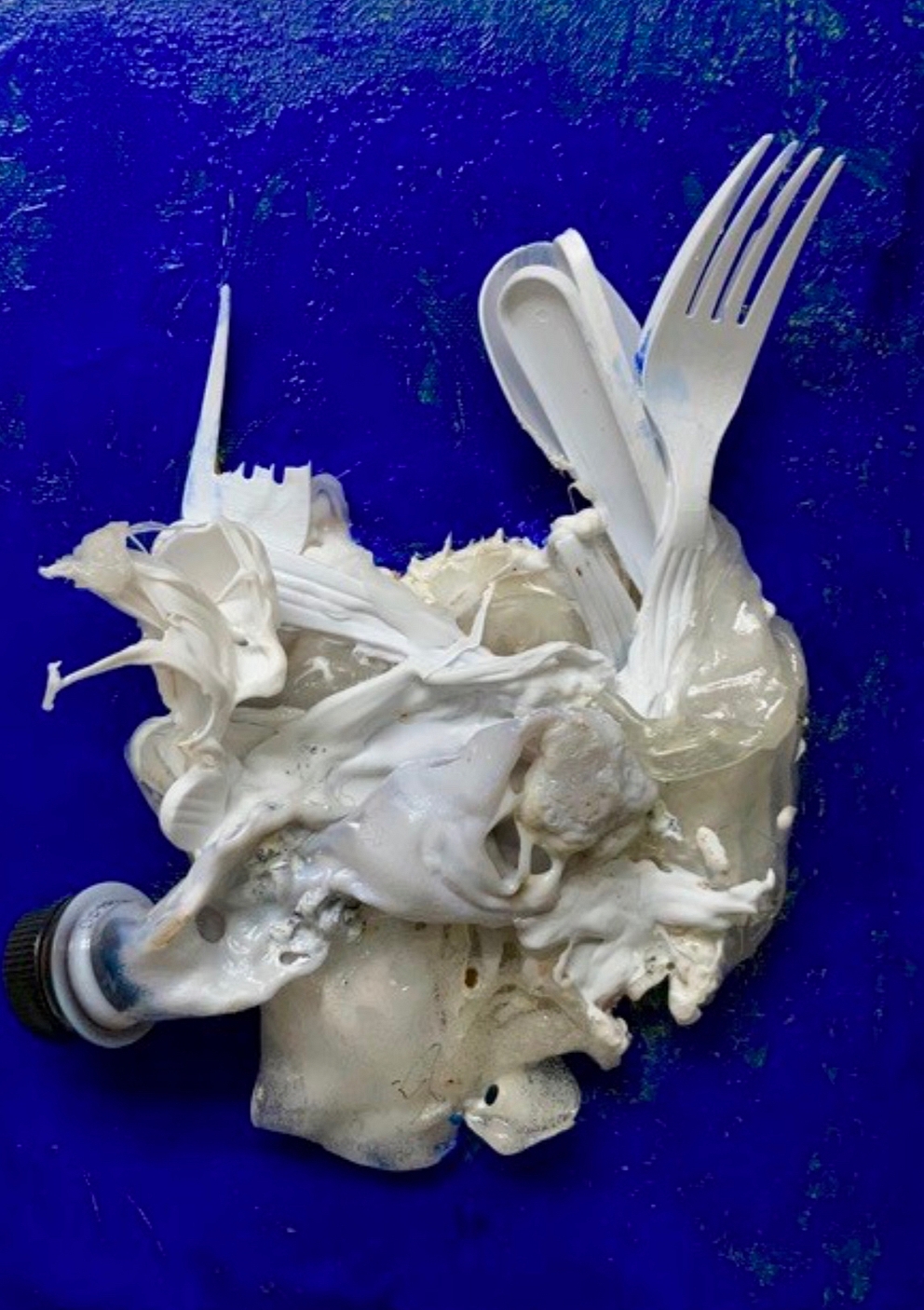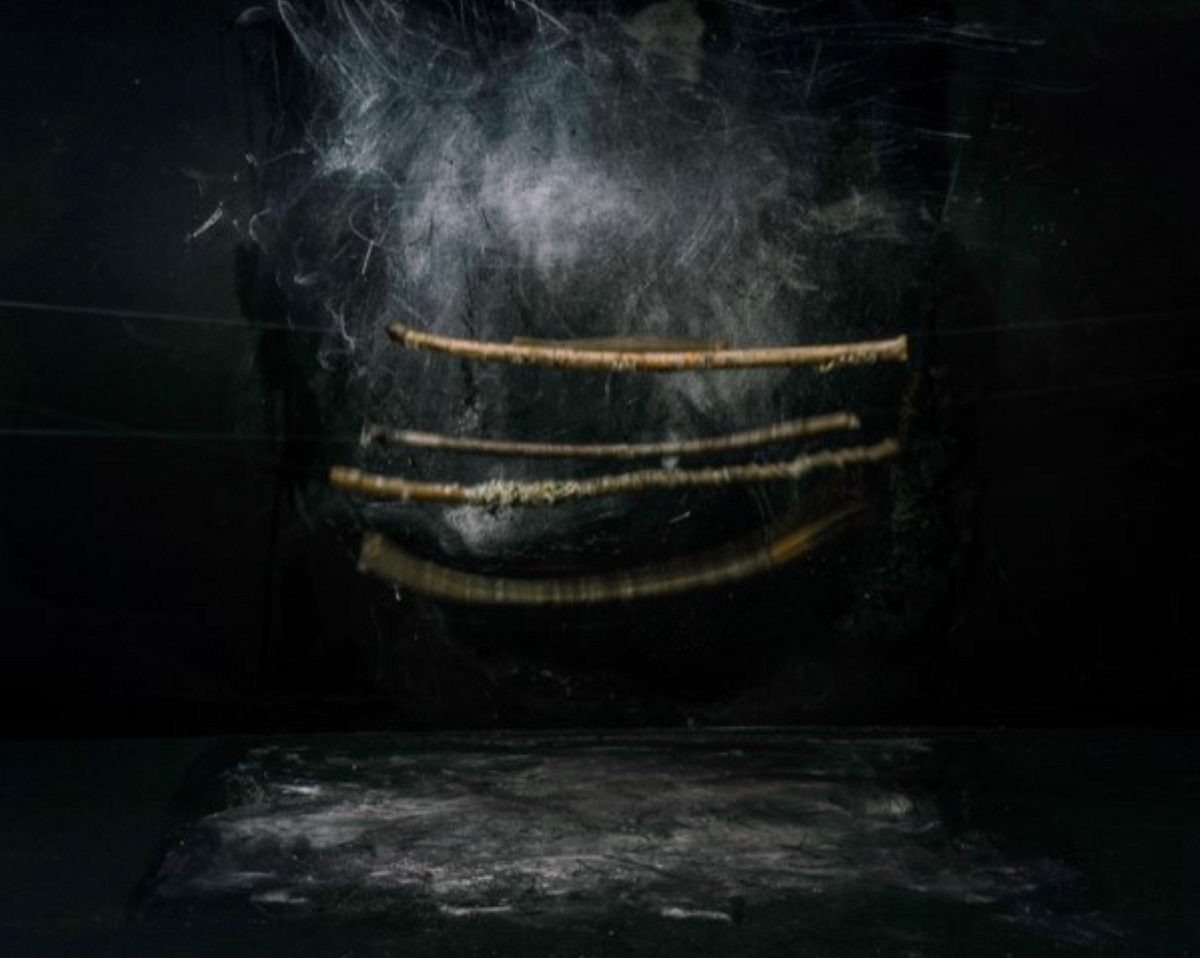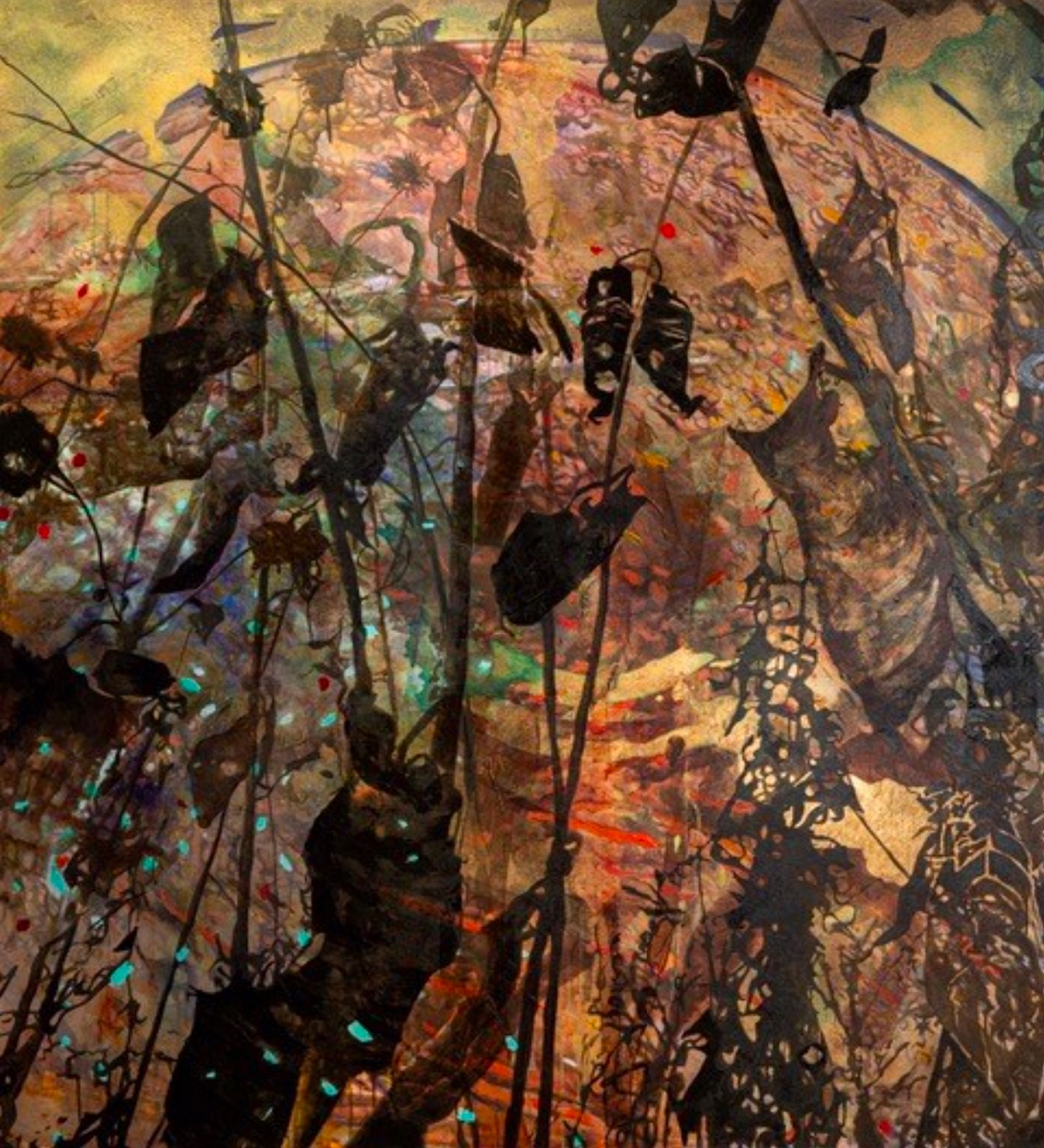
Susan Hoffman Fishman
The Earth Is Breaking Beautifully.
Susan Hoffman Fishman’s painting seems at first to be an abstract, full of brilliant colors and bold lines. Soon, though, one can see how it’s derived from natural forms — but at what scale? It could be a cross-section of a tree or a landscape viewed from space. It turns out that it’s more the latter.
“As a result of climate change, the extraction of minerals and the damming of the Jordan River, which once provided a source of new water to the Dead Sea, over 8,000 sinkholes have developed along its shores. Seen from above via satellites and drones, the sinkholes are brilliant cobalt blue, lime green, white, yellow ochre and rust red,” the artist writes. “The Earth is Breaking Beautifully emphasizes the contrast between the horrifying destruction around the Dead Sea and the beauty of that destruction.”
Hoffman’s language, starting with the title, is jarring; it talks about climate change in a way we’re not used to. Typically we hear about climate change in opposed political terms. On one side are those who deny it’s happening. On the other are those who accept the science but frame it in purely destructive terms. Fishman’s language makes room for another sentiment: a sense of awe.
It’s one way into “Biophilia: In Excelsis,” an exhibition at the Institute of Sacred Music on Prospect Street, running now through May 2. The show “focuses on the theme of our sacred ecosystems, including oceans and forests, and their imminent transformation due to increased global warming. The exhibit brings together 22 artists who represent different cultural backgrounds, generations and geographic locations, who explore the concept of biophilia, the love of life,” writes M. Annenberg, the show’s curator.
Fittingly for the institution hosting it, the show approaches environmental concerns from a spiritual perspective — and one that isn’t at odds with science. “We are children of the Big Bang. The atoms, dust and fire that created our universe flow through our blood and bones,” Annenberg writes. “We are on a journey to wholeness, to recovery, to a new world born on the ashes of a heedless selfish and destructive one.…
“As we observe our ecosystems in free fall — wildfires consuming billions of living beings in Australia, the loss of a billion sea creatures off the coast of Vancouver, atmospheric rivers and rain bombs crushing whole towns in streams of endless water, while rivers dried up on three continents last summer — the Yangtze, the Rhine and the Colorado — we are left to wonder how it came to this, a Judeo-Christian society based on the ten commandments, with Buddhism, Hinduism, and Islam all professing a love for creation.”

Walter Brown
Quick Lunch #1.
In our environmental depredations, “have we lost this sense of the sacred so clearly understood by hunter-gatherer societies?” Annenberg continues. “Chief Seattle, in 1852, said ‘Every part of the earth is sacred to my people. Every shining pine needle, every sandy shore, every mist in the dark woods, every meadow, every humming insect. All are holy in the memory and experience of my people.’ … We ask the audience to find the sacred in our forests, our water, our multitude of species. Rather than through an organized religion, we must seek a new connectivity, an ecospirituality that resides in the manifested world, that we are ordained to save.… May it be our mission to help bring about an ‘ecozoic era’ coined by Thomas Berry, to create a new paradigm for a society devoted to the well being of all species, both human and non-human.”
The artists in “Biophilia” take on different aspects of this larger mission. Walter Brown’s piece “uses his own recyclable plastic waste,” an accompanying note explains; the title suggests that the piece above was made from the plastic from one takeout lunch. “His work expresses concerns about overconsumption, environmental carelessness and misguided priorities. By converting plastic waste into art, he draws attention to the need for sensible approaches to ensure sustainability.” Brown has recycled the plastic by making it into art. But the piece also points out that art alone isn’t enough. This was one day’s lunch. What about the next day, and the next? How fast will it pile up, and how do we prevent that?

Janet Culbertson
Clearcut.
Other pieces, such as Janet Culbertson’s from 1970 — the age of the piece alone is enough to remind us that we’ve known about climate change for far longer than we’d care to admit — force us to confront the devastation. “Global warming, the burning of the rainforests, the oiling of Alaska, and the extinction of innumerable animals and plants have profoundly influenced my work. I fear the human species may pollute the Earth to death. Most of us want to run from the frightening doom and gloom messages now hitting the front pages, but there just isn’t any place to go,” Culbertson writes. But her image is also profoundly compelling; it taps into the dual meaning of apocalypse, denoting both a catastrophe and revelation, the moment we finally understand.

Suzanne Theodora White
Vibration.
Suzanne Theodora White also carries a glimmer of something resembling hope in her piece while not avoiding the reality. “I think of generational memory. Every year, every generation, we adjust to a new normal with what remains of our fragmented natural world,” she writes. “What will happen when there is no one to remember when the skies were darkened by birds and forests stretched for thousands of miles? In my work I am asking can art carry the knowledge of lost worlds while confronting what the future may bring and can we find beauty in what remains?”

Cameron Davis
Earth Rise Amen.
Cameron Davis’s piece captures the sense of death and renewal — a deeply spiritual theme if ever there was one — in the piece Earth Rise Amen. The plants in the piece could be scorched out of existence; it could also simply be fall, and the plants ready to grow back again. “Perceiving our shared subjectivity with living organisms, the use of patterns, primarily plant imagery, serves as a reference to life and our co-existence with a living earth,” Davis writes.
All told, in combining the perspectives of science and spirituality, the show gives voice to an approach to climate change that offers a way forward, past the denial and past the gloom and doom, into a hard-earned positivity, one with a sharp edge to it. We’ll learn acceptance and adaptation in part because we have to, whether we like it or not; the choice we have is our attitude in doing so. Do we constantly look back and mourn, try to cling to what’s already been lost? Or do we look forward, to the environment as it is and as it will be, and see a way to live in it, with it, that brings us some grace and peace? These kinds of questions aren’t being asked very often yet. But in time, they may be the only ones that matter.
“Biophilia: In Excelsis” runs at the Institute of Sacred Music, 406 Prospect St., through May 2. Admission is free. Check the ISM website for hours and more information.